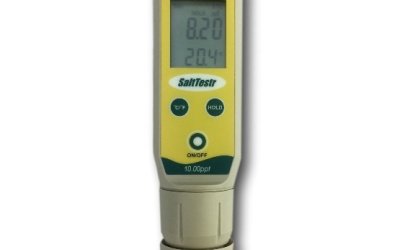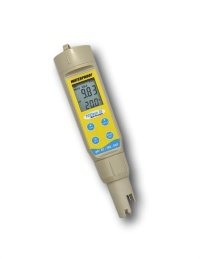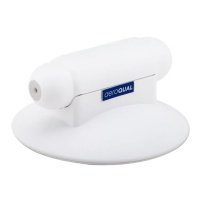Caring for your EC-SaltTestr11

Regular maintenance of your salinity meter will prolong its life and guarantee accurate readings. Instrument Choice scientists often recommend the EC-SaltTestr11 salinity meter because, not only is it easy to use, thankfully, it's also straightforward to maintain.
Calibration
Calibration is a critical step to ensuring the EC-SaltTestr11 is performing at the highest possible level of accuracy.
Calibration should be performed at regular intervals, when a meter is giving inaccurate results or after installing a new electrode. Watch an Instrument Choice scientist calibrate the EC-SaltTestr11 in the video below or read the step-by-step calibration guide here.
Video 1: Watch an Instrument Choice Scientist calibrate the EC-SaltTestr11 here.
Electrode Maintenance
Always keep the sensor electrodes clean. Soiled electrodes will have a diminished ability to obtain accurate salinity measurements.
After each use, rinse the electrode with deionised water and wipe dry with a clean cloth before storing back away in the protective cap.
If you are experiencing reduced performance or the electrode is particularly soiled, a deep clean may be necessary. Soak the electrode in isopropyl alcohol for 10 to 15 minutes and then rinse well with deionised water.
Video 2: Watch an Instrument Choice Scientist can a conductivity meter using isopropyl alcohol here.
Electrode Storage
Storing the electrode within a protective cap is an essential way to keep it safe and clean when not in use.
Always store the clean electrode in the included electrode cap.
Batteries
Maintaining an adequate source of power is fundamental to ensuring continuously accurate measurements. The EC-SaltTestr11 has a battery indicator on the LCD screen; see the low battery indicator table below. When the low battery indicator starts blinking, replace the four 1.5V A76 micro alkaline batteries.

Open the battery compartment lid, remove the old batteries by pulling the plastic ribbon, and replace it with new batteries. Observe the polarity when inserting your new batteries.
Electrode Replacement
You need to change the electrode module when the tester fails to calibrate or gives inconsistent or fluctuating readings in calibration standards. You can replace the electrode module at a fraction of the cost of a new tester. To replace;
Twist off the ribbed collar above the electrode. Set aside the collar and O-Ring.
Unplug and discard the old electrode.
Gently plug in the new electrode by aligning the tabs on the electrode. Push the O-ring from the old electrode back onto the new electrode module.
Push the ribbed collar back onto the electrode and twist until tight.
Recalibrate the meter with the new electrode prior to taking measurements.

Conclusion
Maintaining and caring for your EC-SaltTestr11 salinity meter is essential for accurate measurements. Regular maintenance will also prolong the life of your meter.
If you have any questions or need help with any of the maintenance steps listed above, contact one of the Instrument Choice scientists, we're here to help! Call 1300 737 871 or email [email protected].
Also interesting
Adequate care and maintenance are crucial for accurate results, satisfactory performance, and prolonging the life of your EC-PCSTestr35 Multi-Purpose Meter. Instrument Choice Scientists have assembled the essential maintenance tips for this device in an easy-to-follow Maintenance Guide.

Carbon monoxide is an odourless, colourless, tasteless gas that can have adverse effects on the human body if it accumulates to dangerous levels. Common carbon monoxide producing items within the home include catalytic heaters, fireplaces, and various gas burning appliances such as gas heaters.
Get informed about carbon monoxide, its effects on the human body, and the preventative measures you can take in the home to reduce the risk to you and your family.

